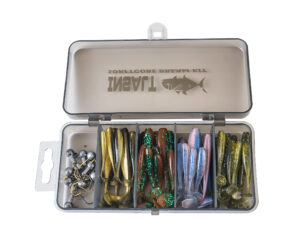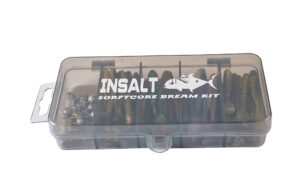Mastering Bream on Soft Plastics: Techniques, Tackle & Tactics for Australian Waters
Catching bream on soft plastics has become one of the most exciting and effective ways to target this iconic Aussie species. Whether you’re casting in urban canals, brackish estuaries, or along sunken oyster racks, soft plastics offer a level of finesse, versatility, and fun that’s hard to beat.
In this comprehensive guide, we’ll explore everything you need to know to consistently catch bream on soft plastics — including gear selection, rigging, retrieve techniques, seasonal movements, and expert tips to help you outfish the competition.
Understanding Bream Behaviour
Before diving into technique, it’s essential to understand how bream behave.
Species Breakdown
In Australian estuaries, you’ll typically encounter:
-
Black Bream (Acanthopagrus butcheri) – common in southern Australia
-
Yellowfin Bream (Acanthopagrus australis) – dominant in eastern regions
-
Pikey Bream (Acanthopagrus berda) – found in northern estuaries and creeks
All share similar traits — they’re structure-oriented, wary, opportunistic feeders that respond well to natural presentations and subtle techniques.
Habitat
Bream are highly structure-oriented. You’ll find them around:
-
Boat hulls
-
Rock walls
-
Bridge pylons
-
Mangroves
-
Fallen trees
-
Oyster leases
-
Pontoons
They feed on crustaceans, worms, molluscs, and small baitfish, which makes soft plastics an ideal artificial option when mimicking their natural prey.
Why Soft Plastics Work So Well for Bream
Soft plastics excel because they allow you to:
-
Mimic natural prey with lifelike movement
-
Present lures slowly and subtly
-
Cover water efficiently
-
Fish vertically or horizontally
-
Choose various shapes, colours, and sizes
They also offer the angler control over fall rate, action, and depth — all crucial when targeting pressured or finicky bream.
Essential Tackle for Soft Plastic Bream Fishing
Rod Selection
A light, responsive rod is key. Ideal specs:
-
Length: 6’0″ to 7’2”
-
Power: 1–2kg or 2–4kg
-
Action: Fast or extra-fast tip for strike detection
-
Example: Insalt Finesse Explorer 1-2kg 6`3 Spin or BFS baitcaster
For finesse-style breaming, many prefer ultralight rods around 1–3kg. Rods like the Insalt Finesse Explorer or a quality graphite stick with a solid tip help detect subtle bites and improve plastic control.
Reel Selection
-
Size: 1000–2500 spinning reel
-
Drag: Smooth, with fine adjustment
-
Weight: Lightweight for balance
-
Brands to consider: Shimano, Daiwa, Okuma, Insalt
Line & Leader
-
Main Line: 3–6lb braid (high-vis for bite watching)
-
Leader: 4–8lb fluorocarbon, up to 10lb in heavy structure
-
Go as light as 2–3lb for spooky fish, but use 8–10lb when fishing oyster racks or pylons
Best Soft Plastics for Bream
Plastic Styles That Work
-
Grubs & Curly Tails
-
Great for slow, fluttering presentations
-
Ideal for beginners
-
Mimics worms or shrimp
-
Examples: Z-Man GrubZ, Insalt Paddletail Critters
-
-
Paddle Tails
-
Offer vibration and action on slow retrieves
-
Effective in dirty water or when bream are aggressive
-
-
Creature Baits & Critters
-
Imitate crabs, yabbies, shrimp
-
Deadly around structure
-
Work best with subtle hops and pauses
-
-
Stickbaits / Flickbaits
-
Great for darting actions
-
Effective on schooling bream or in open flats
-
Best Sizes
-
2” to 3” plastics are perfect for bream
-
Occasionally upsize to 3.5” for trophy fish or when targeting bycatch like flathead
Colour Tips
-
Natural colours like motor oil, watermelon, and bloodworm for clear water
-
Brights and UV colours (chartreuse, pink) for stained or dirty water
-
Glitter works well in sunlight to mimic scale flash
Jighead Selection
Choosing the right jighead is vital. You want just enough weight to hit the bottom and maintain control, but not so much that it kills your presentation.
Weight Guide
-
1/16oz (1.8g) – Most common for shallow flats (0.5–1.5m)
-
1/12oz (2.5g) – Good for deeper water (2–3m)
-
1/8oz (3.5g) – For strong current or fast sink
Hook Size
-
#2, #4, #6 hooks are best for bream
-
Choose wide-gap, chemically sharpened hooks for better hook-up rates
Retrieve Techniques That Work
1. Slow Roll
-
Cast, let it sink, and slowly wind back
-
Works well with paddle tails and grubs
-
Ideal over flats and weed beds
2. Hop & Pause
-
Short sharp rod lifts with pauses in between
-
Imitates fleeing shrimp or yabbies
-
Deadly with creature baits or curl tails
3. Shake & Drag
-
Twitch the rod tip subtly while slowly dragging the plastic
-
Keeps lure near bottom longer
-
Great when fish are inactive
4. Dead Stick
-
Let the plastic sit still after casting
-
Especially effective with scented plastics
-
Bream often inhale a motionless lure after inspection
Where and When to Fish
Tides
-
Bream respond best to incoming tides around structure
-
Top of the tide is ideal for casting into tight cover
-
Run-out tide can push fish into deeper channels and drop-offs
Seasons
-
Summer & Autumn: Bream are aggressive, often in shallow water.
-
Winter: Fish deeper, slower, and with finesse — they’re lethargic but still feeding.
-
Spring: A transition period; fish feed actively around spawning sites.
Best Times
-
Early mornings and late afternoons are peak bite windows
-
Overcast days extend bite periods
-
Night sessions with soft plastics can also be productive near lights or marinas
Tips for Fishing Different Structures
Oyster Racks
-
Cast close and fish fast – use heavier leader (8–10lb)
-
Creature baits excel
-
Strike and pull fish out immediately to avoid bust-offs
Bridge Pylons
-
Let the plastic sink right alongside the pylons
-
Use vertical hops or dead stick
-
Bream often sit on the shaded side
Sand & Mud Flats
-
Ideal for slow-rolling or hopping curly tails
-
Look for drains, weed patches, and channels
-
Long casts and stealthy approaches are key
Boat Hulls & Marinas
-
Cast parallel to hulls and under pontoons
-
Shake-and-drag presentations work best
-
Often heavily pressured, so go light and slow
Scent & Extras
Bream can be picky — especially in clear or pressured waters. Using scent can dramatically increase your catch rate.
-
Add scent like Pro-Cure or S-Factor every 20–30 mins
-
Scent helps mask human smells and encourages fish to hold on longer
-
Also helpful when using unscented plastics
Land-Based vs Boat/Kayak
While boats and kayaks offer greater access to structure, land-based anglers can still catch plenty of bream with the right approach.
Land-Based Tips:
-
Focus on rock walls, jetties, bridge pylons, and canals
-
Walk-and-cast style works well on flats and drains
-
Carry a light shoulder bag with minimal gear and a handful of proven plastics
Common Mistakes to Avoid
-
Too heavy a jighead – kills the natural sink rate
-
Fishing too fast – bream often prefer a slow, subtle approach
-
Using thick leader – spooks fish in clear water
-
Not reapplying scent – especially after multiple casts or missed bites
Final Word
Catching bream on soft plastics is one of the most rewarding forms of lure fishing in Australia. It’s affordable, accessible, and loaded with finesse. Whether you’re a beginner or seasoned angler, there’s always something to learn and improve.
By mastering your gear, matching the hatch, refining your retrieve, and understanding how bream behave, you’ll be well on your way to consistent catches.
So grab a pack of plastics, tie on a light leader, and head to your local estuary. The next big bream is only a subtle tap away.


